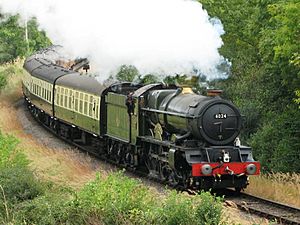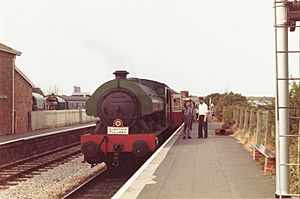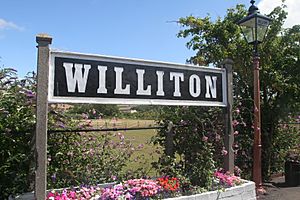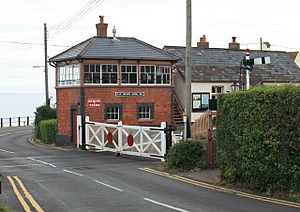West Somerset Railway facts for kids
Quick facts for kids West Somerset Railway |
|
|---|---|

The steam engine 6024 King Edward I climbs a hill on the railway.
|
|
| Locale | Somerset |
| Terminus | Minehead Bishops Lydeard |
| Commercial operations | |
| Built by | West Somerset Railway Minehead Railway |
| Original gauge | 7 ft 1⁄4 in (2,140 mm) |
| Preserved operations | |
| Operated by | West Somerset Railway plc |
| Stations | 11 |
| Length | 22.75 miles (36.61 km) |
| Preserved gauge | 4 ft 8 1⁄2 in (1,435 mm) |
| Commercial history | |
| Opened | 1862 |
| 1862 | Opened Taunton to Watchet |
| 1874 | Opened Watchet to Minehead |
| 1882 | Converted to 4 ft 8 1⁄2 in (1,435 mm) |
| Closed | 1973 |
| Preservation history | |
| 1975 | Light Railway Order granted |
| 1976 | Reopened Minehead to Williton |
| 1978 | Reopened Williton to Stogumber |
| 1979 | Reopened Stogumber to Bishops Lydeard |
| 1987 | New station at Doniford |
| 2009 | New station at Norton Fitzwarren |
| Headquarters | Minehead |
The West Somerset Railway (WSR) is a 22.75-mile (36.6 km) heritage railway in Somerset, England. A heritage railway is like a working museum, preserving and running old trains on a historic line. The land and stations are owned by Somerset Council, but the railway is run by a company called West Somerset Railway plc. This company gets help from charities that love old trains. The WSR runs both classic steam trains and old-fashioned diesel trains.
The railway first opened in 1862, connecting the towns of Taunton and Watchet. In 1874, the line was extended to the seaside town of Minehead. For many years, it was a busy line, especially in the summer when tourists flocked to the coast. However, British Rail closed the line in 1971. Luckily, it was saved and reopened as a heritage railway in 1976.
Today, it is the longest standard gauge heritage railway in the United Kingdom. Most trains run on the 20.5 miles (33.0 km) route between Minehead and Bishops Lydeard. For special events, some trains travel a bit further to Norton Fitzwarren, where the line connects to the main national railway network.
Contents
Journey Through Time
In the mid-1800s, many people wanted to build railways in Somerset. They saw it as a way to transport goods from the coast and to bring tourists to see the beautiful countryside of Exmoor.
Building the First Line
In 1856, a group of local people decided to build a railway. They hired the famous engineer Isambard Kingdom Brunel to help them plan the route. Brunel suggested a line from the port town of Watchet to Taunton, where it could connect with the main Bristol and Exeter Railway.
Construction began in 1859 and took nearly three years. The line from Taunton to Watchet finally opened for passengers on 31 March 1862. It was a single track built to Brunel's wide "broad gauge" standard.
Extending to Minehead
People soon wanted to extend the railway to the popular seaside town of Minehead. A new company, the Minehead Railway, was formed to build the extra section of track from Watchet. This new part of the line opened on 16 July 1874. The whole route from Taunton to Minehead was then operated as a single branch line.
The Great Western Railway Years
In 1876, the powerful Great Western Railway (GWR) took over the line. A few years later, in 1882, the track was changed from broad gauge to the "standard gauge" that is used across Britain today.
The GWR made many improvements to handle the growing number of holidaymakers. They added extra tracks called "passing loops" at stations like Crowcombe Heathfield, Blue Anchor, and Bishops Lydeard. This allowed more trains to run on the single line at the same time. In the 1930s, the line was made even busier with more upgrades, including doubling the track between Dunster and Minehead.
Decline and Closure
In 1948, all of Britain's railways were "nationalised," meaning they were taken over by the government and became part of British Railways. But by the 1960s, many branch lines like this one were losing money. A famous report called the Reshaping of British Railways recommended closing thousands of miles of track across the country, including the Minehead line.
Even a visit from The Beatles in 1964, who filmed a scene for their movie ... Hard Day's Night at Crowcombe Heathfield, couldn't save it. Goods services were stopped, and the line was slowly run down. The last train ran on 2 January 1971.
Saved as a Heritage Railway
After the closure, a group of railway fans and local people formed the West Somerset Railway Company to try and reopen the line. They knew how important it was for tourism. Somerset County Council agreed to buy the line in 1973 and lease it to the new company.
It took a lot of hard work by volunteers to clear the overgrown tracks and fix the stations. The line reopened in stages:
- 1976: Minehead to Blue Anchor
- 1978: Extended to Stogumber
- 1979: The full line to Bishops Lydeard was running again.
Since then, the railway has become a major tourist attraction. A new station was built at Doniford Halt in 1987, and another at Norton Fitzwarren in 2009. The railway is now a living piece of history, enjoyed by thousands of people every year.
A Trip Along the Line
Let's take a journey from Minehead to Bishops Lydeard. The direction towards Taunton is called the "up" direction.
Minehead to Watchet
Towns on this part of the route: Minehead, Dunster, Blue Anchor, Washford, Watchet
Our trip starts at Minehead station, right by the sea. The station has a long platform, a cafe, and workshops where the engines are cared for. After leaving the station, the train runs on a long, straight track behind Butlin's holiday camp.
Soon, we arrive at Dunster station. The village and its famous castle are on a hill to our right. The line then heads back towards the coast, running along the edge of the beach to Blue Anchor. This station has a passing loop, so we might see another train waiting here. There is also a small museum on one of the platforms.
From Blue Anchor, the train turns inland and starts to climb a steep hill. We travel through the countryside to Washford station. The old goods yard here was used by the Somerset and Dorset Railway Trust to restore old carriages. The line then goes downhill towards the historic harbour town of Watchet.
Watchet to Bishops Lydeard
Towns on this part of the route: Watchet, Williton, Stogumber, Crowcombe, Bishops Lydeard
Watchet station is unusual because the main building faces away from the platform, as it was once the end of the line. The old goods shed is now a boat museum.
Leaving Watchet, the train climbs along the cliffs of Helwell Bay. We pass the small platform at Doniford Halt before arriving at Williton. This is the halfway point of the railway and a very busy station. It has a passing loop, workshops for steam and diesel engines, and a beautiful garden with a 100-year-old hedge.
The line continues to climb into the lovely Quantock Hills. We reach the quiet station of Stogumber, which has a pretty garden where the goods shed used to be. The climb continues until we reach the highest point on the line at Crowcombe Heathfield. This is another beautiful country station with a passing loop.
From here, it's all downhill. The train travels through the countryside, passing close to the village of Combe Florey. Soon we arrive at Bishops Lydeard, the end of our journey for most regular services. This station has a museum in the old goods shed and is where many of the railway's volunteers are based.
How the Railway Works
Running a heritage railway is a big job that needs careful planning and lots of skilled people, many of whom are volunteers.
Train Services
The railway runs trains from March to October, with special services at other times of the year, like Christmas. On busy summer days, there can be up to eight trains each way.
Most trains are pulled by steam or diesel engines, but sometimes special "railtours" from the main national railway network visit the line. The railway also sometimes carries freight, such as stone for sea defences or old track materials for recycling.
Signalling
To keep trains safe on a single line, the railway is divided into sections called "blocks." Only one train is allowed in a block at a time. The signalmen in the signal boxes use a system called an "Electric Key Token." A driver must have the metal token for a section before they can enter it. This prevents two trains from meeting head-on.
The signal boxes at stations with passing loops, like Williton and Crowcombe Heathfield, control the points and signals that let trains pass each other safely.
Rolling Stock
The railway is home to many different steam and diesel engines. Many are the same types that would have been seen on the line in the past, like the GWR "Prairie" tank engines. Others are from different railways, like the powerful Somerset and Dorset 7F engine.
Most passenger trains are made up of British Rail Mark 1 coaches. These are painted in a traditional brown and cream colour scheme, similar to the one used by the Great Western Railway. There is also a special dining train called the Quantock Belle, with coaches painted to look like luxury Pullman cars.
Films and Television
The scenic railway has been a popular location for filming.
- ... Hard Day's Night (1964) The famous band The Beatles filmed scenes at Crowcombe Heathfield station.
- The Flockton Flyer (1977–78) A children's TV show about a preserved railway was filmed here.
- The Lion, the Witch and the Wardrobe (1988) This BBC series also used Crowcombe Heathfield as a location.
- The Land Girls (1997) A movie about women working on farms during World War II was filmed on the railway.
Heritage Groups
The railway is supported by several groups of dedicated volunteers and members.
- The West Somerset Railway Association (WSRA) helped to save the line in the 1970s. It is a major shareholder in the railway company and owns several locomotives and carriages, including the Quantock Belle dining train.
- The West Somerset Railway Heritage Trust (WSRHT) helps to preserve the history of the line. It runs a museum at Blue Anchor and is restoring historic GWR carriages.
- The Diesel and Electric Preservation Group (DEPG) is based at Williton. They look after a fleet of historic diesel locomotives that run on the line.
See also
 In Spanish: Ferrocarril del Oeste de Somerset para niños
In Spanish: Ferrocarril del Oeste de Somerset para niños






